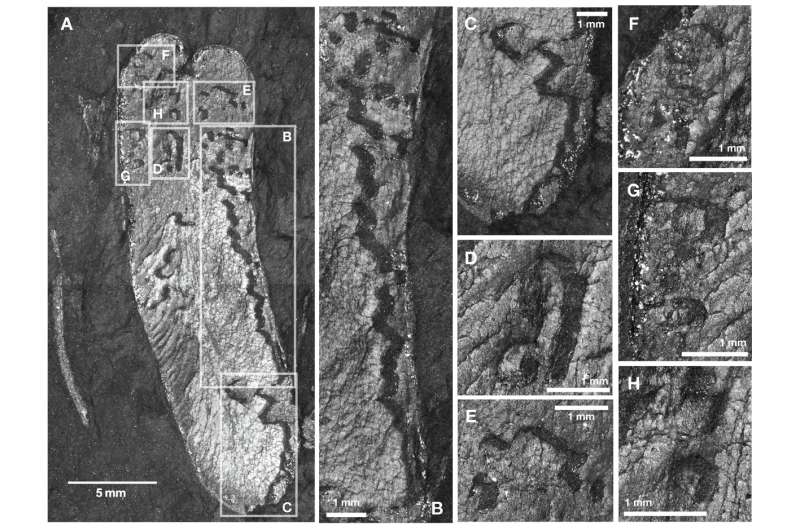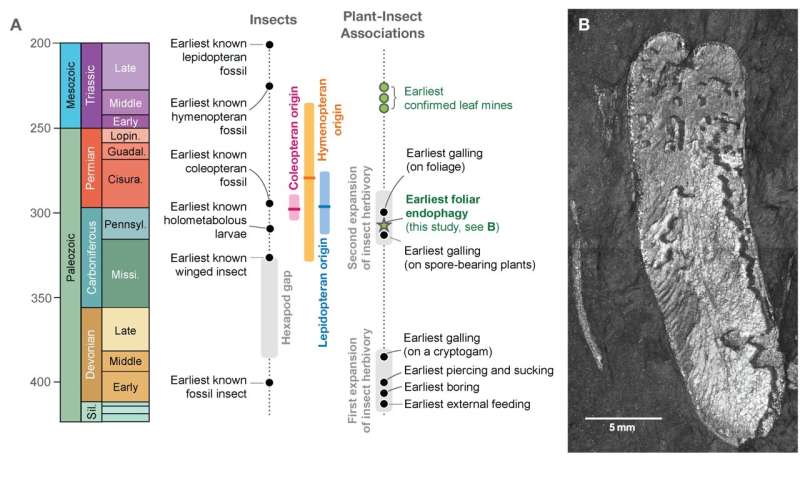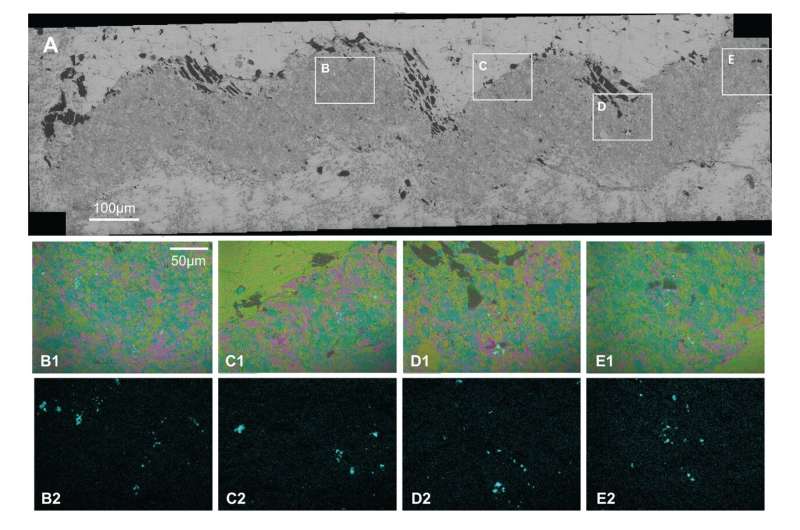This article has been reviewed according to Science X's editorial process and policies. Editors have highlighted the following attributes while ensuring the content's credibility:
fact-checked
peer-reviewed publication
trusted source
proofread
Unearthing the leaf miners of ancient times: 312-million-year-old fossil sheds light on insect behavior and evolution

Insects are fragile, soft-bodied animals whose remains are difficult to preserve. Wings are often fossilized, but insect bodies, if present, are usually bits and pieces of the original prehistoric animal, making it difficult for scientists to study them. One way paleontologists learn about prehistoric insects is by trace fossils, which are almost exclusively found as traces on fossil plants.
"We have a great fossil plant record," said Richard J. Knecht, Ph.D. candidate in the Department of Organismic and Evolutionary Biology at Harvard. "Further back in time, it's the trace fossils that tell us more about the evolution and behavior of insects than the body fossils because plants and the trace fossils on them preserve very well. And the trace, as opposed to a body, won't move over time and is always found where it was made."
In a new study, published in New Phytologist, researchers, led by Knecht, describe an endophytic trace fossil found on a Carboniferous seed-fern leaf that represents the earliest indication of internal feeding within a leaf. The 312-million-year-old Carboniferous fossil provides evidence of how internal feeding, known as leaf mining, may have originated and shows the age of this behavior was occurring approximately 70 million years earlier than believed.
"Of all of the ways that insects feed internally within plants—the mining of the insides of leaves, the tumor-like galls in which an insect takes control of the developmental machinery of a plant, the borings and galleries of insects in wood, and myriad ways that insects invade seeds to consume nutritious embryonic tissues—it is mining that has been the most mysterious," said co-author, Conrad C. Labandeira, Senior Research Geologist and Curator of Fossil Arthropods at the Smithsonian National Museum of Natural History.
"The earliest mines are recorded from the Early Triassic, soon after the great end-Permian extinction, and yet galls, borings, and seed predation extend considerably earlier into the Paleozoic. Why the delay in mining? I think we now have an answer."

Internal feeding on plants is common among holometabolous insects—insects that undergo a full metamorphosis: Lepidoptera (moths), Coleoptera (beetles), Diptera (flies) and Hymenopterans (wasps and sawflies). A larva bores into the leaf and begins to feed on the internal tissues of the leaf, leaving a trail behind. As the larva tunnels within the leaf, it is also growing, going through different stages of molting and even leaving behind it's droppings, known as frass.
"Frass is one of the things we look for when we're identifying internal feeding. Frass can even have different traits that are useful when it comes to defining what animal is making it," Knecht said. The larva will continue to make a trail within the leaf until it pupates, hatches, cuts itself out of the leaf, and flies away.
The trace fossil was found in the Carboniferous Rhode Island Formation. The Rhode Island Formation was originally a swampy, water-logged environment which provided an anoxic setting that preserved plant fossils very well; what paleontologists call a Lagerstätte, a site that produces extraordinary fossils with exceptional preservation.
"One thing that doesn't fossilize is larvae," said Knecht. "They are too delicate and small. So seeing something like this is really insightful because it tells us about larval behavior at a specific time, the late Paleozoic, in which we know very little about larvae."

The exceptional preservation allowed the researchers to clearly see the endophytic trace which follows patterns paleontologists look for when defining this behavior, For example a meandering trail, the larva will avoid the leaf's edges and major veins. This behavior is only known to be performed by holometabolous insects, including animals existing today.
"This finding pushes this behavior back by 70 million years," said Knecht. "It's showing us two things, one the behavior of larvae, something we don't see in the fossil record because larvae typically don't preserve. And two, that the evolution of full metamorphosis, holometabolism, existed at this time."
The fossil is housed in the Museum of Comparative Zoology at Harvard among other fossils Knecht is also studying.
More information: Richard J. Knecht et al, Endophytic ancestors of modern leaf miners may have evolved in the Late Carboniferous, New Phytologist (2023). DOI: 10.1111/nph.19266. nph.onlinelibrary.wiley.com/do … ll/10.1111/nph.19266
Journal information: New Phytologist
Provided by Harvard University





















